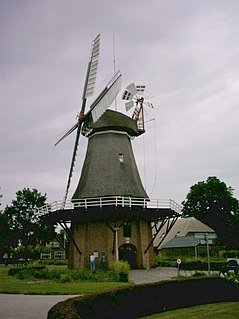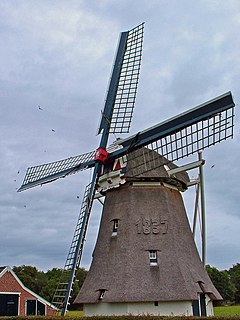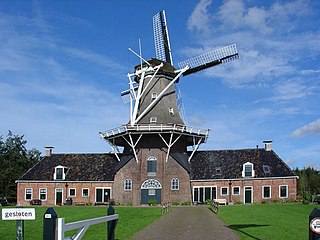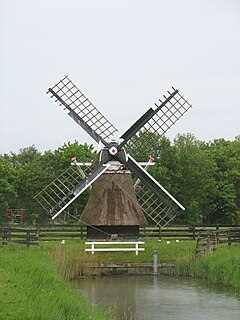
Hazewind is a smock mill in Gieten, Drenthe, Netherlands. It was built in 1833 and has been restored to working order. The mill is listed as a Rijksmonument, number 16126.

De Weert is a smock mill in Meppel, Drenthe, the Netherlands. It was built in 1998 and is listed as a Rijksmonument, number 526385.

De Sterrenberg is a smock mill in Nijeveen, Drenthe the Netherlands. It was built in 1977. The mill is listed as a Rijksmonument, number 30957.

De Mûnts is a smock mill in Buitenpost, Friesland, Netherlands which has been restored to working order. The mill is listed as a Rijksmonument, number 7039.

De Zwaluw is a smock mill in Burdaard, Friesland, Netherlands which is working commercially. The mill is listed as a Rijksmonument, number 15585.

De Hoop is a smock mill in Norg, Drenthe, the Netherlands. It was built in 1906 and is listed as a Rijksmonument, number 30781.

Noordenveld is a smock mill in Norg, Drenthe, the Netherlands. It was built in 1878 and is listed as a Rijksmonument, number 30785.

De Zwaluw is a smock mill in Oudemolen, Drenthe, the Netherlands. It was built in 1837 and is listed as a Rijksmonument, number 38148.

Woldzigt is a smock mill in Roderwolde, Drenthe, the Netherlands. The mill has two functions; a corn mill and an oil mill. It was built in 1852 and is listed as a Rijksmonument, number 32541.

The Molen van Rolde is a smock mill in Rolde, Drenthe, the Netherlands. The mill was built in 1873 and is listed as a Rijksmonument, number 32698.

Windlust is a smock mill in Burum, Friesland, Netherlands which was built in 2014, replacing an earlier mill that had burnt down on 8 April 2012.

De Hoop is a smock mill in Dokkum, Friesland, Netherlands which was built in 1849 and has been restored to working order. The mill is listed as a Rijksmonument, number 13186.

Zeldenrust is a smock mill in Dokkum, Friesland, Netherlands which was built in 1862 and has been restored to working order. The mill is listed as a Rijksmonument, number 13097. The name translates as, "Seldom at rest."

Welgelegen or Tjepkema's Molen is a smock mill in Heerenveen, Friesland, Netherlands, which was built in 1849 and has been restored to working order. The mill is listed as a Rijksmonument, No. 21171.

The Munnekezijlstermolen is a smock mill in Munnekezijl, Friesland, Netherlands which was built in 1856 and is in working order. The mill is listed as a Rijksmonument.

De Phenix is a smock mill in Nes, Ameland, Friesland, Netherlands which was built in 1880 and is in working order. The mill is listed as a Rijksmonument.

De Kaai is a smock mill in Sleat, Friesland, Netherlands which was built in 1755 and is in working order. The mill is listed as a Rijksmonument.

De Kleine Molen is a smock mill in Stiens, Friesland, Netherlands which was built in 1913 and moved in 1988. The mill is the smallest of its type in the Netherlands. In working order, it is listed as a Rijksmonument.

De Hoop is a smock mill in Sumar, Friesland, Netherlands which was built in 1867 and is in working order. The mill is listed as a Rijksmonument.

De Vrouwbuurstermolen is a smock mill in Vrouwenparochie, Friesland, Netherlands which was built in 1862 and is in working order. The mill is listed as a Rijksmonument.





















